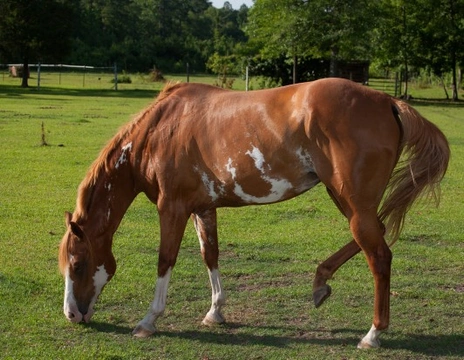
Is a Box Foot a Problem for Horses?
In the majority of cases a box foot is not a problem in horses and if the condition is noticed early enough in weanlings at around six months old, careful trimming as well as establishing the underlying cause, may help improve the shape of the foot as a horse reaches maturity. The first sign there may be a problem is when the coronary band appears more prominent which results in a more upright looking hoof. If left untreated, the dorsal wall becomes dished which results in the walls growing excessively causing the foot to be boxed and very upright.
However, if an older horse has a box foot and they are performing successfully, it is far wiser to leave the foot as it is rather than attempt to make it look normal as this will result in unbalancing the horse and put extra strain on tendons.
What Causes a Box Foot?
It's believed there could be several things that may cause a horse to develop a box foot which includes the following:
- Genetics
- OCD problems
- Ephiphysitis
- Diet
- DOD
- Lameness which results in reduced weight bearing on an affect foot
OCD Problems Explained
OCD (osteochondritis dissecans) affects cartilage and bone found in a horse's joints and is a relatively common issue with an estimated 5 to 25% of horses being at risk of developing the condition. It's typically caused by a combination of things which includes the following:
- A rapid growth and larger than normal body size
- High energy diets or imbalances when it comes to trace elements which includes diets that are low in copper
- A genetic disorder
- Imbalances in hormones – both thyroid and insulin
- Trauma which includes through exercise
Ephiphysitis Explained
Also known as physitis, this condition typically affects young horses and is a bone disease that affects growth plates found in longer bones namely the tibia, cannon and radius bones. The condition is more commonly seen in horses when they are around 4 to 8 months old which is when they experience rapid spurts of growth. The exact reason why some young horses develop the condition is unknown but it is thought that horses carrying too much weight and which are fed a high calorie diet at more at risk of developing the condition.
DOD Explained
DOD (Development Orthopedic Disease) is a condition where cartilage does not mature correctly so that it fails to develop into bone. It's thought that a combination of things are responsible for horse developing the condition which includes the following:
- Genetics
- Nutrition
- Exercise
It is really important that owners take into consideration the breed of horse, their conformation, diet fed to a pregnant and lactating mare, diet of a young horse and general horse husbandry which all helps reduce the risk of horses developing the condition.
Frequent Trimming May Help Reshape a Box Foot
As long as the condition is caught early enough, frequent trimming of an affected foot with the end goal being to lower the heel whilst at the same time protect the toe, can help reshape the foot so it becomes a better and more normal shape. However, as with any other disease the outcome really does depend on the severity of the condition and the sort of treatment a farrier or vet may recommend.
In older horses, if the condition leads to constant lameness, a vet may recommend surgery which might help. The procedure would lower the heel and address the shape of the foot as a whole and these days there are some very good composite materials used to protect the toe. This helps prevent any further deterioration in the shape of the foot.
Foals with a box foot tend to also be back at the knee"" and occasionally a vet might prescribe oxytetracycline to help relax tendons but this is only a temporary solution which can result in making the condition worse. In short, the use of oxytetracycline is therefore guarded when treating young foals with a box foot.
Horses Can Perform Very Successfully With a Box Foot
Even though a horse may have a box foot, they are still able to perform extremely well with quite a few well-known horses with the condition having become successful athletes in various disciplines. In short, if a horse is diagnosed with a box foot, it is not the end of the world and therefore should not be thought of as being disastrous.
With this said, as soon as the condition is diagnosed in a young horse, as previously mentioned, it's important to start an aggressive treatment to reshape the foot over time as soon as possible. This helps reduce the chance of the condition developing into a more severe case which could cause a horse to be lame. In short, the rule of thumb is that the earlier a box foot is detected and treated, the more chance of it being successful which in turn means a horse would be able to go on and perform successfully in a chosen discipline.
Conclusion
Horses with box feet are able to perform very well and there are many well-known and successful competition horses around which demonstrates that it's not the end of the world if a horse does have a box foot. However, if a young horse is diagnosed with the condition, the sooner a treatment is started to reshape the hoof the better the outcome. Careful trimming and treating the root cause of the problem will result in a better shape foot when a horse reaches maturity.
""



